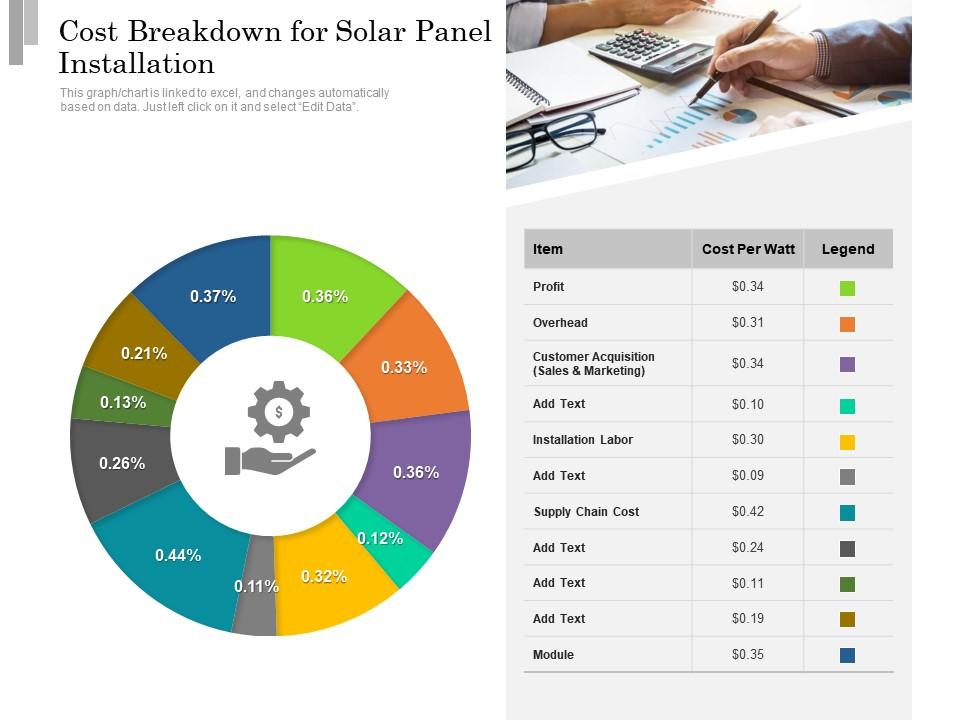
Unveiling the Economics: Navigating the Landscape of Solar Installation Costs
Embarking on the journey of solar adoption involves a crucial consideration: the costs associated with solar installation. This article delves into the various factors influencing solar installation costs, explores ways to manage expenses, and highlights the long-term benefits of investing in solar energy.
Understanding the Components of Solar Installation Costs
Solar installation costs consist of several components, each contributing to the overall investment. The major elements include solar panels, inverters, mounting equipment, electrical components, and labor. The quality and efficiency of these components can influence the upfront costs of the installation.
The Impact of Solar Panel Quality and Efficiency
Solar panels are a critical component of any solar installation. The type, brand, and efficiency of the panels influence both the upfront costs and the long-term performance of the system. While high-efficiency panels may have a higher initial cost, they can lead to greater energy production and savings over the system’s lifespan.
Inverter Efficiency and Functionality
Inverters play a crucial role in converting the direct current (DC) electricity generated by solar panels into usable alternating current (AC) electricity for homes or businesses. The efficiency and functionality of inverters impact the overall performance of the solar system. Investing in high-quality inverters may contribute to better energy yields and overall system efficiency.
Labor Costs and Professional Installation
Professional installation is a key factor in ensuring the optimal performance and safety of a solar energy system. Labor costs encompass the planning, design, and actual installation of the system. While professional installation incurs additional expenses, it is a crucial investment that contributes to the reliability and efficiency of the solar installation.
Government Incentives and Rebates
Government incentives and rebates can significantly offset solar installation costs. Many governments worldwide offer financial incentives, tax credits, or rebates to encourage individuals and businesses to adopt solar energy. Researching and taking advantage of available incentives can make solar installation more financially feasible.
Financing Options and Solar Leasing
To make solar installation more accessible, various financing options are available. Solar leasing, for example, allows individuals or businesses to install solar panels without the upfront costs. Instead, they pay a fixed monthly fee. Exploring financing options can make solar energy accessible to a broader range of consumers.
Evaluating Long-Term Savings and Return on Investment
While the upfront costs of solar installation may seem significant, evaluating the long-term savings and return on investment (ROI) provides a more comprehensive picture. Solar panels have a lifespan of 25 years or more, and the ongoing savings on electricity bills can offset the initial investment, leading to substantial financial benefits over time.
Technological Advances and Cost Reductions
The solar industry is dynamic, with continuous technological advancements and cost reductions. As solar technologies evolve, prices tend to decrease, making solar installation more affordable. Staying informed about industry trends and leveraging advancements can contribute to managing solar installation costs effectively.
Customization and Scalability
Solar installation costs can be influenced by the size and complexity of the system. Customizing the system to match specific energy needs and considering scalability options for future expansions allow for more flexibility in managing costs. A well-designed system can adapt to changing energy requirements over time.
Educational Resources for Informed Decision-Making
Education is a powerful tool in navigating the landscape of solar installation costs. Exploring resources that provide information about solar technology, financing options, and available incentives empowers individuals and businesses to make informed decisions about their solar investments.
Exploring Solar Installation Costs Further
For comprehensive insights into solar installation costs and strategies to make solar energy more affordable, visit Solar installation costs. This resource offers valuable information on factors influencing costs, available incentives, and the long-term economic benefits of adopting solar energy.
Conclusion: Illuminating the Path to Solar Affordability
In conclusion, understanding and managing solar installation costs are crucial steps in harnessing the power of solar energy. While the initial investment may pose a financial consideration, the long-term benefits, coupled with government incentives and technological advancements, make solar energy an increasingly affordable and sustainable choice. By navigating the economics of solar installation wisely, individuals and businesses can embark on a path towards cleaner, more affordable energy for the future.



